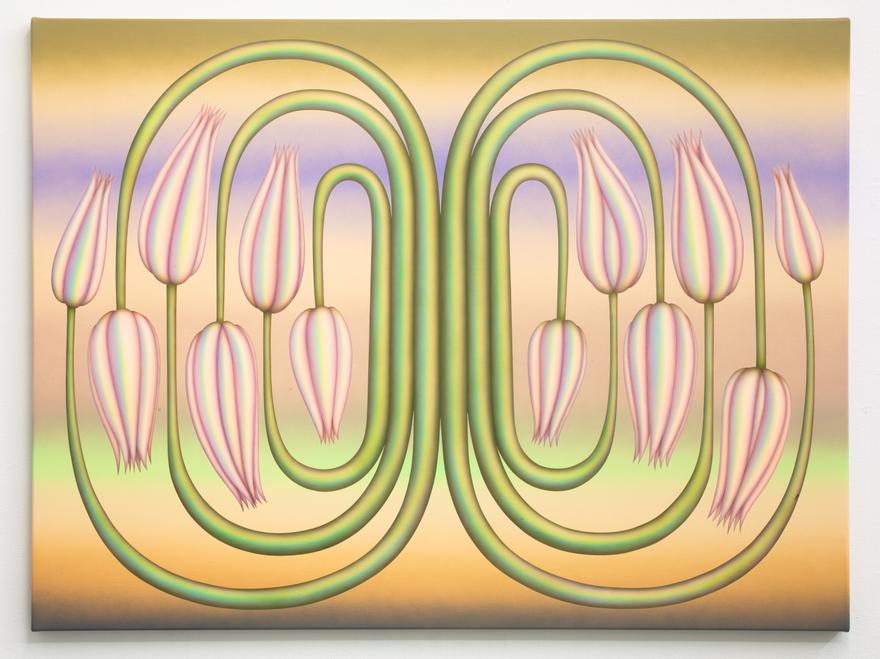
March 26 - May 16, 2021
Kapp Kapp, New York is pleased to present Molly Greene: Splitting. This exhibition marks Greene’s debut solo exhibition in New York and her second exhibition with Kapp Kapp. Greene’s recent body of work reconsiders our collective relationships with built environments. Through the lens of her signature flora, Greene playfully critiques notions of the femme while further confronting our elemental social structures.
The term ‘Splitting’ in itself quite aptly defines Greene’s new suite of canvases; both noting the repetition of mirrored and (a)symmetrical imagery while connoting a scientific connection, which could both refer to the splitting of the atom or a laboratory-like dissection. Take Greene’s Doublespeak, 2021, which splays an unfurled, ivory flower toward the bounds of the surface. At once the vibrant stems of the organism turbulently grow in separate directions, while the composition maintains a tacitly understandable order. Though its symmetry is not exact, the system of controlled entropy is reminiscent of the technology and mechanisms of an atomic weapon, in this case constructed of a traditionally femme object.
Greene’s process evokes a particular autonomy within her objects, as if each painting has a life or story beyond its canvas, as is notable in All Watched Over by Machines of Loving Grace, 2021, which is appropriately titled after Richard Brautigan’s 1967 poem describing a technological utopia. In this piece, the stems of the purple flower, which divide the piece into almost-precise quadrants, drift around the perimeter of the painting, imagining a continued narrative beyond the visible. Greene often considers the history and association of femininity with passivity, which has been pervasive in Western literature and culture since Descartes in the 17th century. By offering her traditionally femme objects a sovereignty and narrative beyond what is seen, Greene seeks to turn this historical association on its head.
In considering “splitting” itself, Greene is attracted both to splitting at the scale of a species and at the scale of an individual. Greene’s largest piece in the exhibition, Tropotaxis, 2021, refers to the system through which an organism orients itself by comparing stimuli at different points of the body. This piece, like the title itself, offers an animalistic energy to the leaf-like organism at center; The plant, which splits at its core, seemingly reaches toward every edge, the leaves divided at each end coiling in its own direction. Like the tongue of a snake forking to triangulate the direction of a scent, Greene imagines a musculature to her organisms and, likewise, a consciousness.
Greene is interested in the dichotomy of object and subjecthood and the transition to and from each, constantly playing with and subverting her viewer’s associations between the two. Take Glad Graft, 2021, which forms a perfect symmetry mirrored across the centerline of the painting. With an industrial precision in shape and form, Greene again constructs her femme object into an architectural, machine-esque subject. Immediately confronted by the exactitude of her organism’s stems, and the chromium-colored palette, one is reminded of a musical instrument or a piece of machinery, a unique system of interconnection used to make a product. However, following the channels of Greene’s “machine,” one discovers quickly the impossibility of the structure, as each flower, leaf, and stem leads directly back to another flower, leaf, and stem, jabbing at our systems of identity and blurring the boundary between natural and unnatural.
Splitting will be on view at Kapp Kapp, New York through May 16.
Molly Greene (b. 1986, Cornwall, VT), lives and works in Los Angeles. Greene received her PhD, MA, and MPhil in American Studies from Yale University and received her MESc in Environmental Science from Yale University. She has exhibited at The Hole, New York; 0-0 LA, Los Angeles; and Ramp Gallery, London. Recent exhibitions include Here, Pittsburgh; Ramp Gallery, London; and Kapp Kapp, Philadelphia.